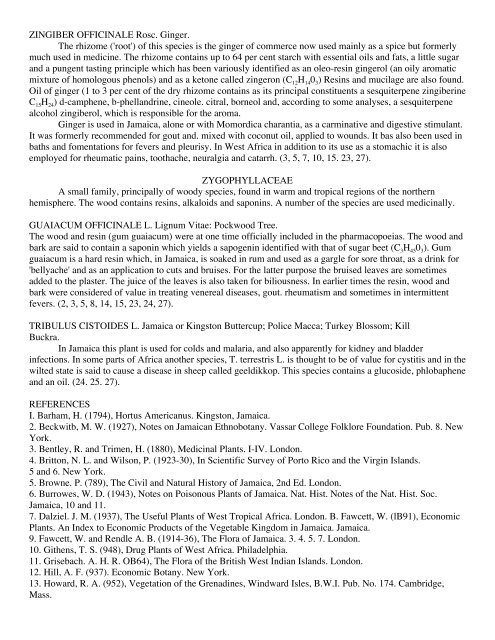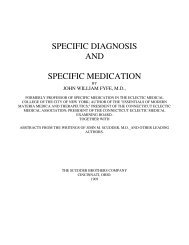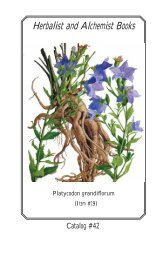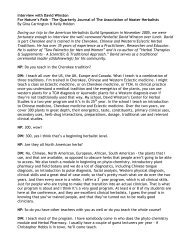MEDlCINAL PLANTS OF JAMAICA. PARTS 1 & 11.
MEDlCINAL PLANTS OF JAMAICA. PARTS 1 & 11.
MEDlCINAL PLANTS OF JAMAICA. PARTS 1 & 11.
You also want an ePaper? Increase the reach of your titles
YUMPU automatically turns print PDFs into web optimized ePapers that Google loves.
ZINGIBER <strong>OF</strong>FICINALE Rosc. Ginger.<br />
The rhizome ('root') of this species is the ginger of commerce now used mainly as a spice but formerly<br />
much used in medicine. The rhizome contains up to 64 per cent starch with essential oils and fats, a little sugar<br />
and a pungent tasting principle which has been variously identified as an oleo-resin gingerol (an oily aromatic<br />
mixture of homologous phenols) and as a ketone called zingeron (C 12H 140 3) Resins and mucilage are also found.<br />
Oil of ginger (1 to 3 per cent of the dry rhizome contains as its principal constituents a sesquiterpene zingiberine<br />
C 15H 24) d-camphene, b-phellandrine, cineole. citral, borneol and, according to some analyses, a sesquiterpene<br />
alcohol zingiberol, which is responsible for the aroma.<br />
Ginger is used in Jamaica, alone or with Momordica charantia, as a carminative and digestive stimulant.<br />
It was formerly recommended for gout and. mixed with coconut oil, applied to wounds. It bas also been used in<br />
baths and fomentations for fevers and pleurisy. In West Africa in addition to its use as a stomachic it is also<br />
employed for rheumatic pains, toothache, neuralgia and catarrh. (3, 5, 7, 10, 15. 23, 27).<br />
ZYGOPHYLLACEAE<br />
A small family, principally of woody species, found in warm and tropical regions of the northern<br />
hemisphere. The wood contains resins, alkaloids and saponins. A number of the species are used medicinally.<br />
GUAIACUM <strong>OF</strong>FICINALE L. Lignum Vitae: Pockwood Tree.<br />
The wood and resin (gum guaiacum) were at one time officially included in the pharmacopoeias. The wood and<br />
bark are said to contain a saponin which yields a sapogenin identified with that of sugar beet (C 3H 450 3). Gum<br />
guaiacum is a hard resin which, in Jamaica, is soaked in rum and used as a gargle for sore throat, as a drink for<br />
'bellyache' and as an application to cuts and bruises. For the latter purpose the bruised leaves are sometimes<br />
added to the plaster. The juice of the leaves is also taken for biliousness. In earlier times the resin, wood and<br />
bark were considered of value in treating venereal diseases, gout. rheumatism and sometimes in intermittent<br />
fevers. (2, 3, 5, 8, 14, 15, 23, 24, 27).<br />
TRIBULUS CISTOIDES L. Jamaica or Kingston Buttercup; Police Macca; Turkey Blossom; Kill<br />
Buckra.<br />
In Jamaica this plant is used for colds and malaria, and also apparently for kidney and bladder<br />
infections. In some parts of Africa another species, T. terrestris L. is thought to be of value for cystitis and in the<br />
wilted state is said to cause a disease in sheep called geeldikkop. This species contains a glucoside, phlobaphene<br />
and an oil. (24. 25. 27).<br />
REFERENCES<br />
I. Barham, H. (1794), Hortus Americanus. Kingston, Jamaica.<br />
2. Beckwitb, M. W. (1927), Notes on Jamaican Ethnobotany. Vassar College Folklore Foundation. Pub. 8. New<br />
York.<br />
3. Bentley, R. and Trimen, H. (1880), Medicinal Plants. I-IV. London.<br />
4. Britton, N. L. and Wilson, P. (1923-30), In Scientific Survey of Porto Rico and the Virgin Islands.<br />
5 and 6. New York.<br />
5. Browne. P. (789), The Civil and Natural History of Jamaica, 2nd Ed. London.<br />
6. Burrowes, W. D. (1943), Notes on Poisonous Plants of Jamaica. Nat. Hist. Notes of the Nat. Hist. Soc.<br />
Jamaica, 10 and <strong>11.</strong><br />
7. Dalziel. J. M. (1937), The Useful Plants of West Tropical Africa. London. B. Fawcett, W. (lB91), Economic<br />
Plants. An Index to Economic Products of the Vegetable Kingdom in Jamaica. Jamaica.<br />
9. Fawcett, W. and Rendle A. B. (1914-36), The Flora of Jamaica. 3. 4. 5. 7. London.<br />
10. Githens, T. S. (948), Drug Plants of West Africa. Philadelphia.<br />
<strong>11.</strong> Grisebach. A. H. R. OB64), The Flora of the British West Indian Islands. London.<br />
12. Hill, A. F. (937). Economic Botany. New York.<br />
13. Howard, R. A. (952), Vegetation of the Grenadines, Windward Isles, B.W.I. Pub. No. 174. Cambridge,<br />
Mass.







